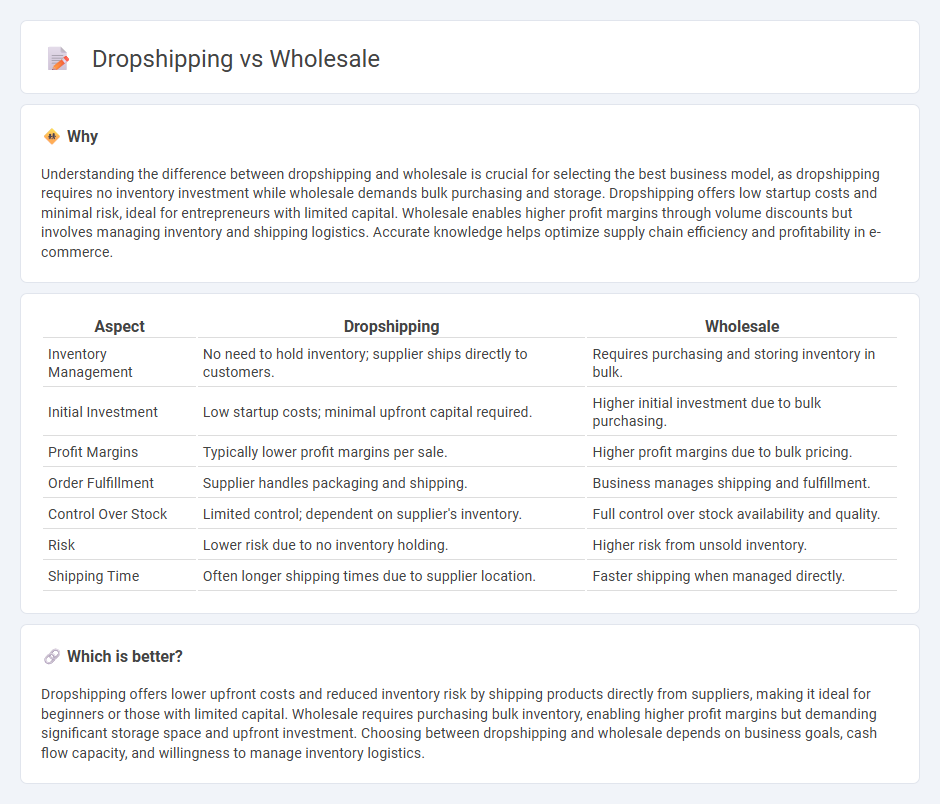
Dropshipping allows retailers to sell products directly from suppliers without holding inventory, minimizing upfront costs and reducing risk. Wholesale requires purchasing bulk inventory at discounted prices, enabling higher profit margins but demanding storage and inventory management. Explore the key differences to determine the best strategy for your eCommerce business.
Why it is important
Understanding the difference between dropshipping and wholesale is crucial for selecting the best business model, as dropshipping requires no inventory investment while wholesale demands bulk purchasing and storage. Dropshipping offers low startup costs and minimal risk, ideal for entrepreneurs with limited capital. Wholesale enables higher profit margins through volume discounts but involves managing inventory and shipping logistics. Accurate knowledge helps optimize supply chain efficiency and profitability in e-commerce.
Comparison Table
| Aspect | Dropshipping | Wholesale |
|---|---|---|
| Inventory Management | No need to hold inventory; supplier ships directly to customers. | Requires purchasing and storing inventory in bulk. |
| Initial Investment | Low startup costs; minimal upfront capital required. | Higher initial investment due to bulk purchasing. |
| Profit Margins | Typically lower profit margins per sale. | Higher profit margins due to bulk pricing. |
| Order Fulfillment | Supplier handles packaging and shipping. | Business manages shipping and fulfillment. |
| Control Over Stock | Limited control; dependent on supplier's inventory. | Full control over stock availability and quality. |
| Risk | Lower risk due to no inventory holding. | Higher risk from unsold inventory. |
| Shipping Time | Often longer shipping times due to supplier location. | Faster shipping when managed directly. |
Which is better?
Dropshipping offers lower upfront costs and reduced inventory risk by shipping products directly from suppliers, making it ideal for beginners or those with limited capital. Wholesale requires purchasing bulk inventory, enabling higher profit margins but demanding significant storage space and upfront investment. Choosing between dropshipping and wholesale depends on business goals, cash flow capacity, and willingness to manage inventory logistics.
Connection
Dropshipping and wholesale are connected through their reliance on suppliers to manage inventory and fulfill orders, enabling retailers to sell products without holding stock. Wholesale involves purchasing goods in bulk at discounted rates to resell, while dropshipping eliminates upfront inventory costs by shipping directly from suppliers to customers. Both models optimize supply chain efficiency and reduce overhead, supporting scalable and flexible e-commerce operations.
Key Terms
Inventory
Wholesale requires retailers to purchase and store large quantities of products, ensuring control over inventory levels and faster shipping times. Dropshipping eliminates the need for inventory management by allowing retailers to sell products directly from suppliers, reducing upfront costs but possibly increasing shipping delays. Explore detailed pros and cons of inventory management in wholesale and dropshipping models to make informed business decisions.
Fulfillment
Wholesale fulfillment involves purchasing bulk inventory, storing products, and managing order shipment, ensuring control over stock and packaging quality. Dropshipping fulfillment relies on third-party suppliers to hold inventory and ship products directly to customers, reducing upfront investment but limiting control over shipping times and product handling. Explore the detailed differences in fulfillment strategies to choose the best model for your business needs.
Profit Margin
Wholesale offers higher profit margins through bulk purchasing discounts, allowing retailers to stock inventory and sell at marked-up prices. Dropshipping reduces upfront costs and inventory risks but typically results in lower margins due to supplier fees and competitive pricing. Explore detailed strategies to maximize profit margins in both wholesale and dropshipping models.
Source and External Links
Wholesaling - Wikipedia - Wholesaling is the sale of goods in bulk to retailers, industrial, commercial, institutional users, or other wholesalers, often involving purchasing directly from manufacturers at discounted rates and selling to end consumers through retailers for profit.
How To Find Wholesale Suppliers (2025) - Shopify - This guide explains how wholesale buying works, highlights top wholesale platforms like Shopify Collective, Alibaba, and AliExpress, and provides tips for sourcing products efficiently in bulk.
Wholesale Fashion Square: Wholesale Clothing and Jewelry Supplier - Wholesale Fashion Square offers bulk wholesale clothing, jewelry, and accessories for women, sourcing products from local manufacturers in Los Angeles to provide trendy, quality fashion at competitive prices across the USA.
 dowidth.com
dowidth.com